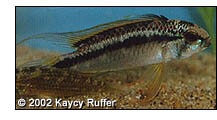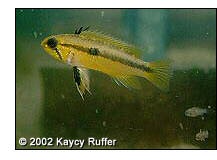 This species is found in the wild in the Amazon; Peru and Brazil and
was first found in 1961.
This species is found in the wild in the Amazon; Peru and Brazil and
was first found in 1961.
I purchased about a dozen very young individuals of Apisto-gramma
bitaeniata in the summer of 1994.
I
set the pair up in a 10-gallon tank containing pure R.O. (Reverse
Osmosis) water, with a half inch layer of fine sand, a plastic plant,
and a two-inch flower pot. The temperature was 76°F. The pH was 7.2 and
the hardness was 50 ppm. I fed the pair newly hatched brine shrimp,
live adult brine, and sometimes ground flakes.
These two turned out to be quite a pair. These
two started spawning at about one and a half inches. Their clutch was
usually around 100 fry per spawn. With this pair the female would not
allow the male near the flower pot while she was tending to her eggs,
which are a yellow to orange coloration depending on the foods fed to
the mother. (This is very common in most Apistos.) The male would
always hide near the front of the tank in front of the sponge filter
until he was allowed to help in the care of the fry. It took between
two and three days to hatch and another five to seven days to be free
swimming. I never noticed the female moving the fry around in the tank.
She just took care of them inside the flower pot where she had spawned.
While looking at the eggs through my camera I
could see there are clear areas at the ends of the eggs. These are
actually a part of the egg and this is where the head and tail will
appear, at opposite ends, as the fry develops. This is the first
indication to me that those particular eggs are fertile.
Another indication to me that these eggs are fertile is the black spots on the yolk sacs.
 When
caring for eggs or fry the females' body and fins took on a deep yellow
hue with a black horizontal line across her side with a black blotch in
the middle of the line. The front part of her ventral fins also turned
black. She was such a beautiful contrast compared to her normal
coloration.
When
caring for eggs or fry the females' body and fins took on a deep yellow
hue with a black horizontal line across her side with a black blotch in
the middle of the line. The front part of her ventral fins also turned
black. She was such a beautiful contrast compared to her normal
coloration.
Once the fry were free swimming I began feeding
them newly hatched brine shrimp. After the fry have been free swimming
for one week the female would finally allow the male to help in the
care of the brood. The interesting thing about the pair that I noticed
was the caring for the fry. The male would stay at one end of the tank
with his 'half' of the brood and the female would stay at the other end
of the tank with the rest of the fry. This separation would go on for
another week and a half and then the babies were everywhere and the
pair were hard pressed keeping their little charges at their respective
ends of the tank.
I also noticed the male took on a yellowing
coloration but not with the intent of the female while caring for his
group of fry. I haven't heard of this color transformation in A.
bitaeniata males from anyone else breeding this species.
When not in brood care colorations the pair are still quite beautiful without the yellowing hue. 



